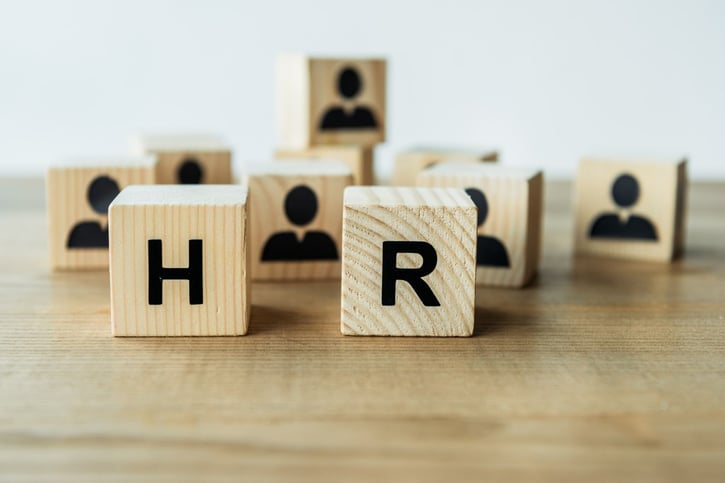What is an HR department structure?
An HR department structure is a framework that outlines how various human resource tasks and responsibilities are organized and carried out in a company.
Depending on the size of your company, the structure can range from a simple setup with one person handling all HR roles to complex department structures where multiple team members focus on specialized HR functions.
Core components of a modern HR department
For many, the human resources department is the backbone of a company. Let's explore the core components in detail:
1. Recruitment and talent acquisition
This is all about finding and bringing in the right people. Depending on the size of your company, you might have a dedicated team or just one person handling this. They use various strategies and tools, ranging from job portals to recruitment drives, to ensure the best talent joins the company.
2. Training and development
After hiring, comes the task of training and development. This is vital to enhance employee skills and ensure they grow in their roles. Methods can vary, but workshops, online courses, and on-the-job training are common ways HR departments ensure career progression.
Useful Read: The 5 stages of team development: Strategies for Success
3. Compensation and benefits
One of the key HR functions is defining pay structures, bonuses, and other benefits. Employee benefits, both monetary and non-monetary, play a huge role in keeping staff motivated. Whether it's health benefits or compensation benefits, a dedicated HR team member or even a whole team might handle this, depending on the number of employees.
4. Employee relations
A harmonious workplace is crucial for productivity. The HR department ensures this by addressing grievances, managing conflicts, and ensuring open channels of communication. Good employee relations also mean celebrating achievements and recognizing team members' contributions.
5. Compliance and legal
Staying on the right side of the law is non-negotiable. The HR team ensures the company adheres to employment laws, regulations, and internal policies. Whether it's about employee contracts or workplace safety standards, HR professionals are on it.
6. HR information systems (HRIS)
In our digital age, technology plays a big role in HR processes. An HRIS helps in digitizing processes and managing data. This can range from attendance tracking to performance reviews, making life easier for both the HR team and other employees.
The changing landscape of HR: Emerging components
The way we structure our HR is undergoing significant changes. With newer challenges and a shift in workforce dynamics, modern HR roles are expanding to include areas that were once overlooked.
Diversity, equity, and inclusion (DEI)
In modern workplaces, DEI is more than just a buzzword—it's a crucial component. Recognizing the importance of DEI means understanding that a diverse workforce brings in varied perspectives, fostering innovation.
The role of the HR manager has now expanded to include promoting these values, ensuring that practices around hiring, compensation and benefits administration, and more, are inclusive and equitable. This not only makes the workplace more inclusive but also appeals to a broader talent pool during recruitment.
Wellness and mental health
The well-being of employees is now center stage. With increasing awareness around mental health, companies are realizing that employee well-being directly impacts productivity and morale. As a result, HR roles now encompass initiatives to support mental health.
This includes ensuring the workplace abides by health and safety regulations, providing resources HR can offer, such as counseling, and even integrating wellness programs. The use of HR software can also help HR departments track and monitor wellness initiatives effectively.
How does an effective HR structure benefit the organization?

Structuring your HR department efficiently can bring about transformative benefits to an organization. Let's delve into the major advantages:
-
Improved employee morale and job satisfaction: A well-structured HR department ensures that everything, from compensation and benefits administration to addressing grievances, is handled smoothly. This creates a supportive environment where employees feel valued and understood.
-
Efficient processes leading to cost savings: With well-defined HR roles and the aid of HR software, processes like recruitment, training, and benefits administration become streamlined. This not only saves time but also results in significant cost savings in the long run.
-
Enhanced company reputation and branding: A company that takes care of its employees and stays updated with the latest in HR, such as DEI and wellness initiatives, naturally earns a positive reputation. This can be a major advantage in recruitment and business dealings, setting the organization apart as a leader in its industry.
In essence, a meticulous and forward-thinking HR structure can be the cornerstone of an organization's success, ensuring it's ready to face future challenges head-on.
Steps to evaluate your HR department structure
Evaluating your HR department structure is essential to ensure that it remains responsive, efficient, and in line with your organization's goals. Regular assessment can help identify gaps, streamline operations, and enhance overall performance.
Here's a step-by-step guide to help you navigate this crucial process:
1. Define clear objectives for the evaluation
Start by understanding why you're conducting the evaluation. Is it to streamline processes, improve employee satisfaction, or ensure compliance with new regulations? Having clear objectives will guide the assessment process and help determine its depth and focus.
2. Gather relevant data
Collect data on the current operations of your HR department. This might include:
- Number of employees managed by each HR team member
- Time taken for key HR processes like recruitment or benefits administration
- Employee feedback on HR services
- Costs associated with each HR function
Useful Read: The Main Drivers of HR costs And Ways to Reduce Them
3. Benchmark against industry standards
Compare your HR structure and performance metrics against industry best practices. This can help you understand where your department stands in comparison to others and identify areas for improvement.
4. Engage stakeholders
Include feedback from various stakeholders such as employees, managers, and even external partners. They can offer valuable insights into the effectiveness of the HR team, areas where they excel, and aspects that might need improvement.
5. Analyze HR roles and responsibilities
Check if roles are clearly defined and if there's a balanced distribution of responsibilities. Ensure that no crucial HR functions are being overlooked and that there aren't any redundancies causing inefficiencies.
6. Consider employee turnover and retention rates
High employee turnover can signal issues within the HR structure or its processes. Delve into the reasons behind departures to identify potential structural or procedural flaws.
7. Conduct a skills gap analysis
Determine if your HR team has all the necessary skills and expertise to handle current and future challenges. If there are gaps, consider training existing staff or hiring new members with the required skills.
A systematic evaluation of your HR department structure not only helps in identifying current shortcomings but also in anticipating future challenges. A proactive approach to assessment can pave the way for a more agile, responsive, and efficient HR team.
Organisational Chart Template
Download Now3 Effective ways to structure your HR department
Organizing your HR department is pivotal for optimizing productivity, maintaining employee satisfaction, and ensuring regulatory compliance.
While the exact structure can vary based on factors such as company size, industry, and strategic goals, there are three commonly adopted frameworks that have proven effective for various organizations.
Here’s a detailed look at each:
1. Functional structure
This traditional method divides the HR department based on specific HR functions. Each function has its dedicated team, ensuring specialization and focused attention.
Components
- Recruitment and talent acquisition: Responsible for identifying, attracting, and hiring new talent.
- Training and development: Focuses on enhancing employee skills and organizing training programs.
- Compensation and benefits: Manages payroll, bonuses, and other benefits.
- Employee relations: Handles grievances, maintains a harmonious work environment, and ensures employee satisfaction.
- Compliance and Legal: Ensures adherence to legal standards and regulations.
Advantages
- Clear definition of roles and responsibilities.
- Deep specialization in each function.
- Simplified decision-making within each function.
Considerations
- Potential for silos to develop, leading to reduced communication between functions.
- Might be less agile in rapidly changing environments.
2. Matrix structure
This approach combines the functional structure with a project-based or team-based structure. While HR professionals still have their primary functional roles, they also work across various projects or teams.
Components
- Functional teams (as described above).
- Cross-functional project or team groups, where members from different HR functions collaborate on specific initiatives or for particular departments.
Advantages
- Enhanced collaboration between different HR functions.
- More agile and responsive to specific project or departmental needs.
- Allows HR professionals to broaden their skill sets by working on diverse projects.
Considerations
- Requires effective communication and coordination.
- Potentially higher complexity in management and decision-making.
3. Centralized vs. decentralized structure
In a centralized structure, all HR decisions and processes originate from a single central HR department. Conversely, in a decentralized structure, individual departments or business units have their HR teams that operate semi-independently.
Components
-
Centralized: A main HR hub that oversees all HR activities across the organization.
-
Decentralized: HR representatives or teams within individual departments or business units.
Advantages
- Centralized: Uniformity in HR policies and processes; economies of scale; streamlined decision-making.
- Decentralized: Tailored HR approaches to specific department needs; agility in decision-making; closer relationships with departmental staff.
Considerations
- Centralized: May be less responsive to specific departmental needs.
- Decentralized: Potential for inconsistencies in HR practices across the organization.
Outsourcing HR functions

The ever-evolving business landscape often pushes organizations to re-evaluate their operational strategies, and the human resources department is no exception.
Outsourcing HR functions has become a popular choice for many businesses, whether it's due to a desire for cost-efficiency, expertise, or scalability.
However, like all strategic decisions, outsourcing has its set of pros and cons. Here's a comprehensive look at them:
Pros of outsourcing HR functions
-
Cost savings: Outsourcing can eliminate the overhead costs associated with full-time employees such as benefits, training, and office space.
Useful Read: How To Calculate the Cost Of An Employee + Free Template
-
Expertise on demand: Firms specializing in HR bring a wealth of experience and knowledge, ensuring that best practices are followed without the need for extensive in-house training.
-
Scalability: It's easier to scale up or down based on business needs when outsourcing, without the commitments of long-term contracts or hiring.
-
Risk management: Professional HR firms stay updated with compliance and regulatory changes, reducing the risk of legal complications for businesses.
-
Focus on core activities: By outsourcing non-core HR activities, businesses can concentrate on their primary objectives and functions.
Cons of outsourcing HR functions
-
Less control: Outsourcing means relinquishing direct control over certain processes, which might not sit well with all businesses.
-
Potential for misalignment: An external firm might not be as ingrained in a company's culture or strategic vision, leading to potential misalignments.
-
Privacy concerns: Outsourcing involves sharing sensitive employee data, which could raise concerns about data privacy and security.
-
Potential quality issues: If not properly vetted, an outsourcing partner might not deliver the expected quality of service.
-
Reduced employee engagement: In-house HR teams often have a better understanding and relationship with employees. Outsourced HR might not have the same level of engagement or trust.
Useful Read: 6 Metrics to Measure Employee Engagement: The Employers Guide
Deciding which functions to keep in-house vs. outsource
To choose which HR functions to retain in-house or outsource, businesses should evaluate their alignment with company culture, the sensitivity of data involved, and the internal expertise available.
Costs, flexibility, and the need for personalized employee interactions should also be considered. Decisions should prioritize the company's unique goals and operational strengths.

Employee scheduling and Time-tracking software!
Conclusion
Whether choosing to operate in-house, outsource, or blend both strategies, the ultimate goal remains the same: to optimize processes, uphold company values, and foster a thriving workplace.
Regularly reviewing and adapting HR structures ensures that businesses remain agile, compliant, and ahead of the curve in an ever-changing environment.


